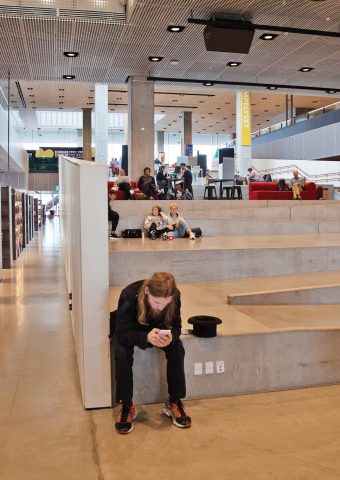Net Zero: Pressures, Progress and Best Practice of Education’s Green Building Plan

The UK’s education sector is under pressure to act on climate change.
Pressure is coming from every angle: from government, from industry and from the students themselves. But why education? If the UK is to reach net-zero emissions by 2050, every sector of the economy will have to make changes, surely?
The reason is straightforward : from primary school to university, buildings play a fundamental role in the sector, making them integral to the fight against climate change. By one estimate, the education accounts for more than a quarter of the government’s emissions, or more than 2% of the entire country’s carbon footprint.
Some progress is already taking shape, but there is much more that academic spaces must do to meet our environmental goals.
Out with the old
The challenge is complex but can be broken down into two key elements – the inescapable fact that the government must build schools and the fact that accountability on actions is far from robust.
Despite the rise of digital remote learning during the pandemic, for school pupils and particularly across higher education, it remains a fact that the need for a school building, a college and a campus is not going to go away. Academic buildings are indispensable.
Sadly, many of the facilities that are in place are no longer fit for purpose and must be replaced – 60% of UK (school) facilities were built before 1976.
On top of that, these older facilities are far from energy efficient and will not help hit emissions targets.
With 91% of students either ‘fairly’ or ‘very concerned’ about climate change, the Office for Students has recommended a consultation on the collection of carbon emissions by providers.
Pointing out that higher education providers are not required to report carbon emissions, and that any reporting is inconsistent, the Office recommended last year that providers reach net-zero emissions by 2030 (Scope 1 and 2) or 2050 (Scope 3).
New Initiatives, New Momentum
In response to these challenges, a range of organisations have called for immediate action – highlighted by the UK’s hosting of COP26 in November.
Race to Zero, a UN-backed initiative, has registered more than 700 higher and further education institutions which are pledging to reach net-zero emissions as soon as possible.
Let’s Go Zero is a similar initiative for schools, with more than 400 signed up for a campaign that also equips them to set a roadmap with carbon targets.
Funding is key
Progress – like pressure – is coming from all fronts. Recently the UK government committed £1bn to cut emissions in a number of buildings, including 36 schools in Greater Manchester, 56 schools in Leicester and 74 schools in Hertfordshire. Hull University Teaching Hospitals NHS Trust will receive £12.6m to install solar panels, heat pumps and roof insulation. That switch to renewable energy will not just benefit the facilities, it will take some pressure off the grid by adding a new source of clean energy.
Smart tools and smarter insights can change behaviour
The Department for Business, Energy & Industrial Strategy ran an £8.8m programme between 2018-20 in which it funded energy saving products for retail, hospitality and schools. The project piloted four smart energy tools– including one from Samsung – to change energy use behaviour within schools.
Combining accessible dashboards, learning resources and competitions between schools to get students involved, the schemes facilitated frequent energy monitoring which was found to have a positive impact on how both students and teachers made an effort to save energy. It revealed areas for improvement, which led to some schools adopting further energy efficient technology.
But the biggest change was behavioural: the programme gave schools a kickstart in pursuing a long-term environmental agenda. Students themselves were seen to have led a collective aspiration to be sustainable.
Passivhaus offers a blueprint
Within real estate, Passivhaus Trust started a campaign to adopt the ultra-low energy Passivhaus building standards for educational buildings in 2020. At a time when the UK needs hundreds of new schools to meet growing demand, these initiatives set out how new academic buildings should be designed and constructed – alongside much-needed retrofits.
Since 2011, there has been a steady pipeline of new schools designed to meet these standards, with 13 completed across England, Scotland and Wales. There are also 10 higher education and research buildings that meet Passivhaus standards and a further nine schools under construction or awaiting certification.
Universities leading the way
The University of Leicester, Centre for Medicine. This is the largest commercial Passivhaus in the UK at about 12,000 sq m – the product of a £42m redevelopment by Wilmott Dixon. Features include a ground air heat exchanger system that cools and heats air entering the building from underground; a 150 sq m PV array and a green wall and roof designed to attract insects and birds.
Leuphana University Lüneburg. The German university is a world leader in zero carbon. Between smart building technology and sophisticated green energy management, such as high-temperature aquifer thermal energy storage, the university produces more energy than it uses, feeding its surplus back into the grid. In fact, it is so efficient that 30% of its emissions come from the (minor) carbon footprint of its 100% renewable energy use.
Wageningen University & Research. Ranked as the most sustainable university in the world by GreenMetric, this Dutch university takes pride in an expansive green strategy. The campus has ‘grey water’ circuits to cut the use of drinking-quality water wherever it can; it generates its own renewable energy with windmill turbines, thermal storage and solar panels; and it has a procurement policy to ensure its supply chains are transparent and sustainable.
University of Nottingham and Nottingham Trent University. Both of Nottingham’s universities are regularly ranked among the most sustainable campuses in the world. Nottingham Trent requires all new buildings to meet BREEAM green standards and recycles 98% of the waste it produces. Down the road, Nottingham University has ambitious carbon reduction targets that it reports on annually, focusing on retrofitting energy intensive buildings. The university also involves students through campaigns and events, such as the Student Switch Off, which encourages students to save energy and water and to recycle – through a competition that includes prizes, of course.
Investing in sustainability leads to positive knock-on effects
A study by the World Green Building Council found that – perhaps unsurprisingly – a better, cleaner and greener learning environment leads to better performance from students. An increase in CO2 in the air corresponded with reductions in school attendance.
A Compelling Case
At a time when most schools are well past their use-by date and the UK needs hundreds more, green building design could not be more important. How well we learn from those leading the way and how well we put their ideas into practice could make or break the UK’s fight against climate change.




Comments
Tell us what you think